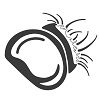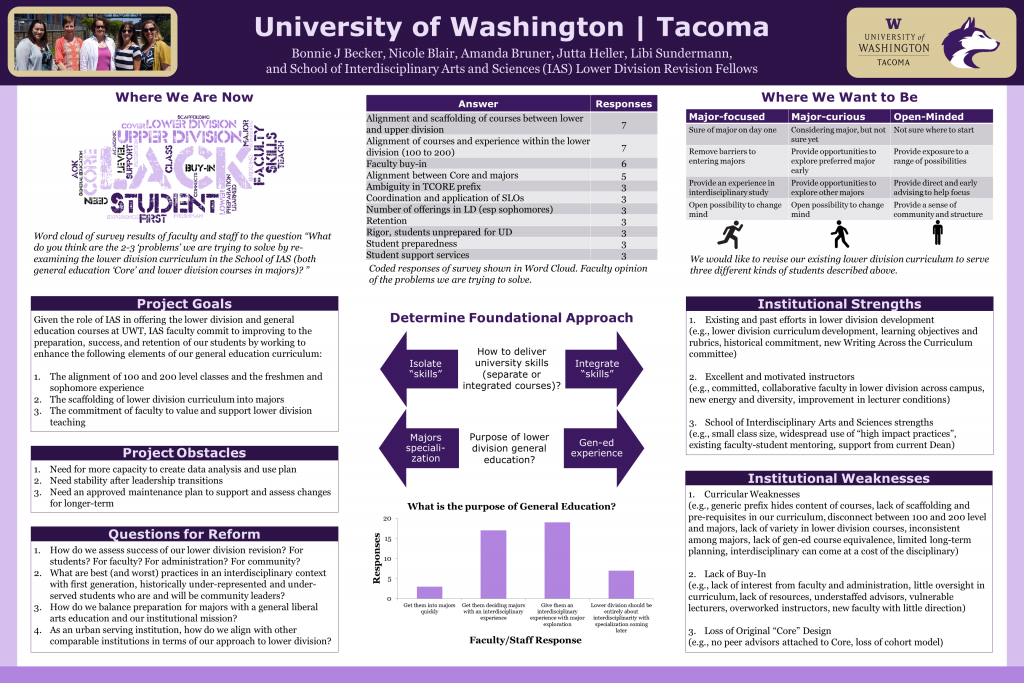Here we take a break from talking about shellfish and larvae, to report on a great education conference I attended with a team from UW Tacoma. Stay tuned to this space for more about our adventures in Puget Sound.
Thank you to the Dean of IAS and the Vice Chancellor of Academic Affairs for their support of our participation in the AAC&U 2015 Institute on General Education and Assessment (IGEA). Also, thank you to the IAS faculty and staff, and campus partners who have dedicated time and energy to re-thinking IAS lower division curricula. Below is an overview of what we learned at IGEA. We hope it represents the start of a generative campus conversation. We are looking forward to sharing more details with IAS faculty and other campus partners who would like to engage with us. Be on the lookout for an invitation to an open meeting on July 22 (UPDATE: video of event here; UW Net ID required), where we will share more details about what we learned.
Background | Institute Overview | IGEA Session Reviews | Next Steps
Background
According to a 2009 survey from the Association of American Colleges and Universities (AAC&U), 89% of the 433 institutions surveyed were conducting some sort of review of their general education program in the past 5 years. At UW Tacoma, we have also begun a conversation about updating our lower division general education core across campus. Since the School of Interdisciplinary Arts and Science (IAS) contributes the majority of courses to general education at all levels, we have convened a representative group from across our divisions, with support from various student service programs, to discuss the general education curriculum in IAS and how it is integrated with our majors. We have three goals: to align the freshmen and sophomore experience, to scaffold the lower division into majors, and to strengthen the commitment of IAS faculty to value and support lower division teaching. More information about our work in the Lower Division Revision Fellows in winter and spring quarters 2015 can be found here (UW Net ID needed).
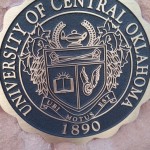 After the progress we made this year, we were thrilled to learn that we were accepted to attend the 25th annual AAC&U Institute on General Education and Assessment (IGEA) held at the University of Central Oklahoma from June 2-5, 2015. Our IGEA team consisted of faculty representatives from the humanities (Nicole Blair, also Assistant Director of the UWT Office of Undergraduate Education), and the social sciences (Libi Sundermann), and the natural sciences (Jutta Heller). We were also joined by a staff member from Student and Enrollment Services (Amanda Bruner, Director of Student Transition Programs), who brought a crucial perspective to our team. I was the team leader representing administration as the Associate Dean of Curriculum and Academic Initiatives.
After the progress we made this year, we were thrilled to learn that we were accepted to attend the 25th annual AAC&U Institute on General Education and Assessment (IGEA) held at the University of Central Oklahoma from June 2-5, 2015. Our IGEA team consisted of faculty representatives from the humanities (Nicole Blair, also Assistant Director of the UWT Office of Undergraduate Education), and the social sciences (Libi Sundermann), and the natural sciences (Jutta Heller). We were also joined by a staff member from Student and Enrollment Services (Amanda Bruner, Director of Student Transition Programs), who brought a crucial perspective to our team. I was the team leader representing administration as the Associate Dean of Curriculum and Academic Initiatives.
Institute Overview
As this was a working institute, we did a lot of preparation before we left. Working with the rest of the Fellows, we created a poster to provide some standardized, fundamental information about our program to share with the 41 other teams from universities around the country attending the Institute. We also discussed our goals and questions for the institute with our larger group, who tasked us to answer the following questions in Oklahoma:
- How do we assess success of our lower division revision? For students? For faculty? For administration? For community?
- What are best (and worst) practices in an interdisciplinary context with first generation, historically under-represented and under-served students who are and will be community leaders?
- How do we balance preparation for majors with a general liberal arts education and our institutional mission?
- As an urban serving institution, how do we align with other comparable institutions in terms of our approach to lower division?
 We were assigned pre-reading, the AAC&U publication “General Education Maps and Markers“, which provided the framework for our work this week. The GEMs approach is based around five design principles: Proficiency, Agency and Self-Direction, Integrative Learning and Problem Based Inquiry, Equity, and Transparency and Assessment. These principles became the natural focus of the IGEA.
We were assigned pre-reading, the AAC&U publication “General Education Maps and Markers“, which provided the framework for our work this week. The GEMs approach is based around five design principles: Proficiency, Agency and Self-Direction, Integrative Learning and Problem Based Inquiry, Equity, and Transparency and Assessment. These principles became the natural focus of the IGEA.
The institute was structured around lots of “Team Time” to work on our Action Plan, a short document outlining a plan for when we return to UW Tacoma. Through intense conversations and synthesis of our new information from the sessions, we built a draft plan to bring back to our fellows group and the IAS faculty. The basic strategy of our plan is to implement a backwards design approach, starting with the goal of what we want our graduates to have when they leave our institution. This is demonstrated by the Signature Work and supported from orientation to graduation. The Signature Work provides the anchor to the IAS experience, and is scaffolded through a digital Academic Narrative. We believe our plan is ambitious yet feasible, and builds on the existing IAS strengths of interdisciplinarity and innovative approach to education. Over the summer, we will further refine this plan with the collaboration of IAS Leadership, the representative Lower Division Revision Fellows, and many other campus constituents. We hope to present a final plan to the IAS Faculty at the retreat in September. 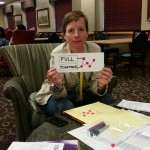 We also were asked to create a bumper sticker that reflects the spirit of our project. We created this logo, meant to reflect the teamwork and forward-motion of a husky sled team, with our desire to “pull together” the lower and upper division curriculum.
We also were asked to create a bumper sticker that reflects the spirit of our project. We created this logo, meant to reflect the teamwork and forward-motion of a husky sled team, with our desire to “pull together” the lower and upper division curriculum.
Much of our time was spent in concurrent seminars and workshops. Since there were six or more concurrent sessions, we strategically distributed our team among the seminars, trying to maximize every member’s attendance in an event from each of the GEMs principles. We then used some of our team time and notes to share what we learned. Below each team member has written a short paragraph about one of their favorite sessions. Truly, the hardest part of the institute was selecting seminars, as we all wanted to go to all of them. We also plan to do a report-out to campus between summer terms A and B, in order to provide an opportunity for those who couldn’t attend to learn more; we will video and distribute this report-out for those who are not around during the summer.
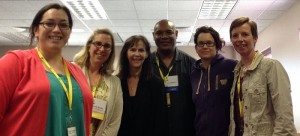 The last component of the institute was the opportunity to consult with the exceptional AAC&U faculty. We had helpful and inspiring conversations with Helen Chen, Dawn Whitehead, Terri Rhodes, Ashley Finley, and Bret Eynon. We learned a lot from all the faculty, and we especially enjoyed our conversations with Yves Labissiere from Portland State University, which is a fellow member of the Coalition of Urban Serving Universities and an informal aspirational institution for many faculty at UW Tacoma. Yves told us about the experience of building and sustaining the general education Universities Studies program at PSU, and gave us guidance and encouragement to bring back to Tacoma. We hope to continue our conversation with Yves and all of the faculty into the future. We also spent time interacting with the other teams, each at a different stage of general education revision and each with useful information to share. A special treat was when we met Mary James from Heritage University, who served on the Washington Higher Education Coordination board and voted to approve the formation of UW Tacoma in 1990. She was thrilled to see how far we had come and we were thrilled to connect with our history while celebrating our future.
The last component of the institute was the opportunity to consult with the exceptional AAC&U faculty. We had helpful and inspiring conversations with Helen Chen, Dawn Whitehead, Terri Rhodes, Ashley Finley, and Bret Eynon. We learned a lot from all the faculty, and we especially enjoyed our conversations with Yves Labissiere from Portland State University, which is a fellow member of the Coalition of Urban Serving Universities and an informal aspirational institution for many faculty at UW Tacoma. Yves told us about the experience of building and sustaining the general education Universities Studies program at PSU, and gave us guidance and encouragement to bring back to Tacoma. We hope to continue our conversation with Yves and all of the faculty into the future. We also spent time interacting with the other teams, each at a different stage of general education revision and each with useful information to share. A special treat was when we met Mary James from Heritage University, who served on the Washington Higher Education Coordination board and voted to approve the formation of UW Tacoma in 1990. She was thrilled to see how far we had come and we were thrilled to connect with our history while celebrating our future.
So clearly, there was also fun to be had in between the hard work. In addition to an evening in the renewed Bricktown neighborhood of Oklahoma City, we performed in the annual closing talent show. We are fortunate to have Nicole, a published singer-songwriter, in our group. Using a limerick (assigned to include the word “Sooner”) written by Amanda, Nicole composed a song for us to sing. If you make it through the rest of the post, I’ll share the lyrics and a photo. There may or may not be a video of the performance, but as we say, “What happens in Oklahoma stays in Oklahoma,” so that’s all we will share.
IGEA Session Reviews
Bonnie Becker
Opening Plenary–General Education for the 21st Century
Given by: Carol Geary Schneider, President of AAC&U
 While I attended many useful seminars and workshops, the opening plenary provided the best big-picture overview of the AAC&U and its tools to transform liberal education as well as the institute as a whole. Geary Schneider framed the institute by providing definitions and the history of both general education and the AAC&U Liberal Education and America’s Promise (LEAP) initiative. A 21st century general education is not defined by the dichotomy of breadth vs depth, but is integrated throughout the curriculum, fosters inquiry and problem solving, and serves all students. Using articulated outcomes, it also includes assessment that can “raise, not just reveal”. She introduced the family of tools that have been developed through or with LEAP to transform higher education, including the Essential Learning Outcomes, High Impact Practices, and the Degree Qualifications Profile. She particularly discussed the GEMs concept of Signature Work, a project that is produced by a student over multiple terms that demonstrates what students can do with their learning. The overall purpose is to allow students to “build capacity to solve unscripted problems”, the ultimate goal of a liberal education. During the rest of the institute, these broad ideas and tools were further explained and explored.
While I attended many useful seminars and workshops, the opening plenary provided the best big-picture overview of the AAC&U and its tools to transform liberal education as well as the institute as a whole. Geary Schneider framed the institute by providing definitions and the history of both general education and the AAC&U Liberal Education and America’s Promise (LEAP) initiative. A 21st century general education is not defined by the dichotomy of breadth vs depth, but is integrated throughout the curriculum, fosters inquiry and problem solving, and serves all students. Using articulated outcomes, it also includes assessment that can “raise, not just reveal”. She introduced the family of tools that have been developed through or with LEAP to transform higher education, including the Essential Learning Outcomes, High Impact Practices, and the Degree Qualifications Profile. She particularly discussed the GEMs concept of Signature Work, a project that is produced by a student over multiple terms that demonstrates what students can do with their learning. The overall purpose is to allow students to “build capacity to solve unscripted problems”, the ultimate goal of a liberal education. During the rest of the institute, these broad ideas and tools were further explained and explored.
Amanda Bruner
Communicating Effectively about the Value of General Education (Sessions 1 and 2)
Led by: Debra Humphreys, AAC&U Vice President for Policy and Public Engagement.
The AAC&U has done a tremendous amount of research with thousands of students, faculty, staff, and employers to ask, ‘What does is mean to be well-educated?’. Findings from their research are available online here. AAC&U research revealed there is significant overlap in what learning outcomes are important to faculty, students, and employers. For example, demonstrated capacity to think critically, communicate clearly, and solve complex problems are valued by all three groups. However, these essential learning outcomes are often discussed in a competitive narrative that can represent false dichotomies. We have to break the idea that providing a liberal arts education and career outcomes are mutually exclusive. In fact, liberal education outcomes and preparation for professional success can be pursued together in mutually reinforcing ways.
Nicole Blair
Getting Started with ePortfolios
Led by: Helen Chen, Director of ePortfolio Initiatives, Stanford University
The most useful session I attended was on how to use e-Portfolios to make a student’s education at the university meaningful as well as useful. The guiding principle of the e-portfolio is that it is an evidentiary story of a student’s progress—it is the record of a PROCESS, not a PRODUCT. The e-portfolio can be used to scaffold the SIGNATURE WORK at the end of the student’s educational journey through the university. It is both reflective/inward looking and outward looking, a projection of how the student will make a contribution in his or her chosen discipline. The EP is thus a collection and a narrative that provides a catalyst for life-long learning. It can be fashioned for many different audiences, depending on what the student wants to use it for: potential employers, or for graduate school, or for advisors along the way (the EP is being added to every quarter and every year). The EP should reflect the messiness of learning, the way in which a student has engaged in “unscripted moments” throughout her or his education. In short, the EP is Evidence-based Storytelling, a kind of enhanced transcript, which the student can use to fashion any number of artifacts or outcomes.
Libi Sundermann
Something to Talk About: Leveraging Diversity for Transformative General Education
Led by: Yves Labissiere, Interim Director of the University Program at Portland State University
This was, intellectually, my favorite session, and it plays a vital role in UWT’s dedication to diversity, and our “DIV” requirement. Labissiere, from Portland State University, deftly and sensitively allowed the participants to identify challenges to diversity (listed below) with the argument that we (as humans, educators, academics, and students) must back up to identify and deal with the challenges (however they may be identified) before we (continue to) identify, discuss, try to understand and/or teach diversity. I strongly recommended we invite Labissiere to IAS to help our school back up our discussions about diversity so that we can continue to develop them. This was an amazing session in which we started to unpack what diversity is—or should be?—but the faculty and participant discussion was so rich we only had time to scratch the surface.
Challenges of diversity discussions, teaching and learning (as given by session participants from their home institutions)
- Predominance of race
- Predominance of race, class, gender
- Stigma of outreach to those seen as “diverse”
- Fear of offending, making mistakes, costs, ostracized, hurt
- Too close to home
- Unaware of privilege
- Denial
- Pervasive micro-aggressions
- Definition (of) exclude
- Institutional embed
- Loyalty
- U.S. focus exclusive
- Going back home
- Academic privilege
- Reform button tradition
- Norm of success
- Us vs. them
- Focus on contemporary rather than historical
Jutta Heller
From Collecting to Connecting the Dots: Excellence in the Design of High Impact Practices
Led by Lee Knefelkamp, Senior Scholar at the AAC&U
 This two-part workshop was the most inspiring one I attended at IGEA15. It was centered around the application of research on different learning styles to the design of educational programs that allow students to become agile learners and thus get a meaningful experience out of their education. Dr. Knefelkamp introduced David Kolb’s Learning Style Inventory, which allows individuals to map their learning preferences on a four-stage cycle including Concrete Experience, Reflective Observation, Abstract Conceptualization, and Active Experimentation. These intersecting axes result in quadrants of four learning styles, each representing a combination of two preferred approaches to learning: Diverging, Assimilating, Converging, and Accommodating (see diagram below). A successful educational program allows students to become agile learners across all quadrants and experience a learning “spiral” in which every turn around the wheel expands their skills and turns them into more mature learners.
This two-part workshop was the most inspiring one I attended at IGEA15. It was centered around the application of research on different learning styles to the design of educational programs that allow students to become agile learners and thus get a meaningful experience out of their education. Dr. Knefelkamp introduced David Kolb’s Learning Style Inventory, which allows individuals to map their learning preferences on a four-stage cycle including Concrete Experience, Reflective Observation, Abstract Conceptualization, and Active Experimentation. These intersecting axes result in quadrants of four learning styles, each representing a combination of two preferred approaches to learning: Diverging, Assimilating, Converging, and Accommodating (see diagram below). A successful educational program allows students to become agile learners across all quadrants and experience a learning “spiral” in which every turn around the wheel expands their skills and turns them into more mature learners.
The Kolb Learning Styles Inventory is a set of 12 questions aimed at identifying how you would take in and deal with a particular experience. The score is then used to map one’s learning style on the wheel. When I completed the Kolb Learning Styles Inventory for myself, I was not surprised by the profile that emerged: When I learn, I prefer to observe first, then do, so my learning preference was centered on the Processing Continuum, with a preference for Reflective Observation.
I plan to use this concept in my courses starting this summer: I would like my students to become aware of their learning styles and identify their preferences. I will ask them to complete the inventory (or some modified version thereof), discuss with them the implications of the results, and take this knowledge into account as I design and/or adjust class sessions and assignments. My goal is to create a more inclusive classroom, one in which every single student, regardless of learning style, will feel that “this class was designed for me!”
Talent Show Limerick
Amanda Bruner and Nicole Blair
IAS at the U Dub Tacoma
Wanted clearer pathways to diplomas.
AAC&U
Said ‘we can help you,
If you come to windy Oklahoma.But the task is harder than it seems,
Like a pillow stuffed with broken dreams.
So we worked day and night,
And with mentor insight,
Made a plan to share with other teams.Now the end came sooner than we wanted,
But we’ll leave dear OKC undaunted.
There is still work to do,
But thanks to all of you,
Our shiny new goals can be flaunted.
Next Steps
We are looking forward to sharing more with IAS faculty and other campus partners who would like to engage with us. On July 22 (UPDATE: video of event here; UW Net ID required) we will have an open forum where we will report out on what we learned and give an introduction to our Action Plan, which we will first share with leadership and the rest of the IAS fellows. We also plan to continue this conversation through the summer and with a working session at the IAS retreat in September. Pull Together!
